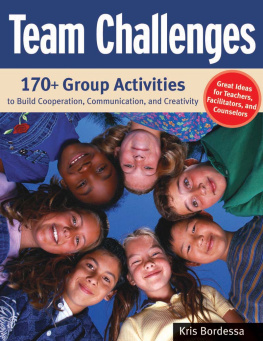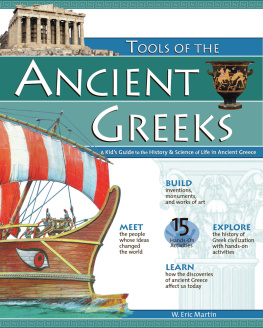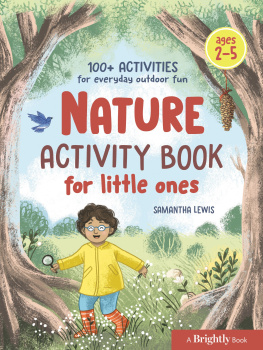
Library of Congress Cataloging-in-Publication Data
Bordessa, Kris.
Team challenges : group activities to build cooperation, communication, and creativity / Kris Bordessa.-- 1st ed.
p. cm.
ISBN 1-56976-201-5
1. Problem-based learning. 2. Group problem solving. 3. Critical thinking. 4. Cooperation. I. Title.
LB1027.42.B67 2006
371.39--dc22
2005013741
All rights reserved. The purchase of this book entitles the individual teacher to reproduce the forms for use in the classroom. The reproduction of any part for an entire school or school system or for commercial use is strictly prohibited. No form of this work may be reproduced, transmitted, or recorded without written permission from the publisher.
Cover and interior design: Rattray Design
2006 by Kris Bordessa
All rights reserved
Published by Zephyr Press
An imprint of Chicago Review Press, Incorporated
814 North Franklin Street
Chicago, Illinois 60610
ISBN 1-56976-201-5
Printed in the United States of America
Contents
What Are They Good For?
Gather Your Group and Prepare for Some Fun
CommonlyUsed Materials and Their Uncommon Us es
Warm Up with These Quick Activities
Discuss Options, Share Ideas, and Make Connections
Building Towers, Bridges, Roads, andMbre
Physical Activities
Improv Hilarity at Its Best
Working Through Some Difficult Spots
Creative-Problem-Solving Programs for Youth
Acknowledgments
A s a DestiNation Imagination team manager, I had trouble finding suitable team-building activities for my groups; as a writer, I was brash enough to take on the project of creating them. The folks at Zephyr Press took me seriously, and in an amazingly smooth process, made it happen.
My fabulous teamsDouble Trouble, The Time Raiders, The Black Knights, The Windboards, and CPWS (Cheezy People Wearing Speedos) have inspired me, tested my limits, and made me laugh until I cried again and again. No matter how I envisioned each task presented to them, they always surprised me with their clever and unorthodox solutions.
Im ever grateful to the friends and family who have cheered me on, proofread pages, and talked me through many frustrationsyou rock!
But most importantly, Ive had the support of my husband and two boys. They have become accustomed to scattered, precariously stacked piles of materials that will some daysome daybecome an eight-minute-long presentation that will test the limits of imagination as can openers pull Trojan Horses to victory, foam pads become armor for the devious Red Knights, and Ayers Rock is transformed into the Golden Gate Bridge. My guys have been patient as I completed this book, graciously (well, most of the time) accepting countless dinners of cold cereal, days without clean socks, and many, many bad hair days. I love you guys.
Introduction
W orking with children can be one of lifes most rewarding experiences. Its also quite a lot like herding cats. Just when you think youve got everyones attention, you find that a stray has wandered off in chase of a butterfly.
As a group leader for several youth organizations, Ive experienced the difficulty of encouraging a group of children to move in the same direction while still respecting each individuals needs. Ive watched as the simple act of compromise has reduced a frustrated child to tears. And Ive seen how, with a bit of guidance, support, and an introduction to creative problem solving, kids can learn to work as a group toward a common goal.
In my role as group leader, I used to find myself constantly in need of new material. I searched my memory for the activitiescampfire skits, relay races, challenges to see who could build the tallest tower or longest bridge, competitions for the most creative cabin decoration, blindfolded lipstick applicationthat I had loved during my own participation in 4-H and other youth programs, and I shared these childhood favorites with my teams. But, while those activities from long ago were a good start, I needed more.
Those fun childhood activities, as well as others that Ive learned more recently, have compelled me to expand on those ideas and develop a resource of easy-to-implement activities that will keep kids laughing, having fun, and learning the benefits of teamwork, all at the same time.
Team challenges offer parents and teachers an easy way to share the concept of creative problem solving with children. Through these simple, handson activities, kids can experiment with building methods, discover new uses for everyday items, try on new personas, and learn to express some unusual ideas as they work toward solving a problem as a team. Your group will learn to work together on projects such as creating a bridge out of marshmallows, straws, and paper or building as tall a tower as possible from toothpicks, raisins, cardboard, and balloons.
Sure, you say. My group could do that. But could they do it in just five minutes? And will their structure hold weight? The tasks found in this book will challenge the minds of the young and the young at heart to come up with a creative solution within specific guidelines and time limits.
Team challenges offer kids a chance to see firsthand how crucial teamwork is to success. By working together on short tasks during each class meeting or team session, participants will begin to understand what it means to work cooperatively with other people.
Grammar school students, high school bands, student council members, pep squads, and even siblingsall of these kids will learn valuable lessons through their participation in team challenges. Whether your group is a team working to solve a long-term problem in an organized competition, a casual youth group, or a group of students, family, and friends, utilizing Team Challenges will encourage cooperation and provide ideas for jump-starting creativity and fostering cooperation.
The early chapters of Team Challenges offer a look at team building and how best to implement the activities in this book with your group. Chapter youll find a list of good materials to keep on hand for last-minute activities as well as potential substitutes.
With this information, youll be ready to start introducing team challenges to your group. Chapter is a good place to start: Tiny Tasks are simple challenges that require a minimum of materials and have very simple instructions.
The rest of the tasks in this book include several different types of challenges. In chapter incorporate a bit of role-playing and acting, as participants utilize props and their creativity to develop a short production, portray a scene, or create a solution to a hypothetical problem.
With practice, your teams will excel at solving these challenges creatively, but in the beginning, they may have some difficulties in learning to work together. Chapter addresses potential trouble spots and offers ideas for smoothing the way.
While the tasks differ in nature, they all have one thing in common: the solutions must come quickly. Teammates often have only a few minutes to discuss their plan and several more to implement it. This teaches them to communicate quickly, effectively, and without conflict. Discussions following the completion of the tasks allow team members to analyze what worked, what didnt, and how they could improve their performance next time. With regular use of these tasks, participants will stretch their knowledge and abilities, learning how to solve a variety of problems.
Every task included in this book requires participants to think creatively, cooperate with one another, and communicate clearly in order to complete the given task. Young people with skills such as these are an asset to their peers, easy to work with, and impressive to watch in action. The ability to work with a team and think outside the box will serve these kids well, not only with their team, but also in the future. Working together creatively to solve the tasks in this book will help provide kids with many of the tools they need to succeed in life.
Next page






